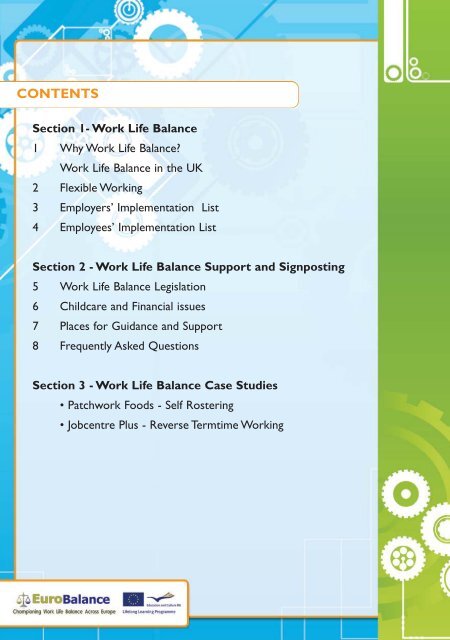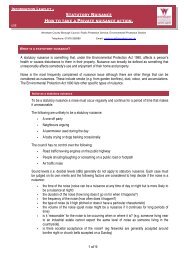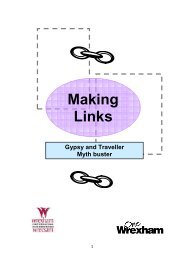Work Life Balance - Wrexham County Borough Council
Work Life Balance - Wrexham County Borough Council
Work Life Balance - Wrexham County Borough Council
Create successful ePaper yourself
Turn your PDF publications into a flip-book with our unique Google optimized e-Paper software.
supporting the combination of working, family and private lives.For both employers and employees effective <strong>Work</strong> <strong>Life</strong> <strong>Balance</strong> canlead to: improved recruitment and retention increased motivation and loyalty improved opportunities for childcare more positive interactions with colleagues, family members andfriends increased work flexibility better productivity reduced absenteeism and stress increased opportunities for training and upskilling improved image of both the company and its staff improved quality of applicants being better equipped to deal with fluctuations in the economicclimateMany employers now offer flexible working and can demonstrateinnovative approaches to managing people and time both on aformal basis and informally.This information pack aims to provide information, signposting andthe tools required by employers and employees to implement andmanage <strong>Work</strong> <strong>Life</strong> <strong>Balance</strong> policies and practices.The pack contains information on the legislative frameworkaround <strong>Work</strong> <strong>Life</strong> <strong>Balance</strong> and Parental Leave as well as flexibleworking options, examples of good practice, case studies andimplementation lists to support employers and employees withthe successful introduction and management of WLB policies andpractices.
<strong>Work</strong> <strong>Life</strong> <strong>Balance</strong> in the UKThe <strong>Work</strong> <strong>Life</strong> <strong>Balance</strong> Campaign was launched in the UK in March2000. A consultation document 'Changing Patterns in a ChangingWorld' was launched by the UK Government and the WelshAssembly Government in 2000. This set out changes in the worldof work as a result of new technology, new opportunities, anincreasingly competitive global market, more women working, feweryounger people and more older people.The purpose of the campaign was to convince employers ofthe economic benefits of <strong>Work</strong> <strong>Life</strong> <strong>Balance</strong> (WLB) by presentingcase studies and to convince employers of the need for change.Since the launch of the campaign WLB initiatives have beenpromoted and supported by the UK and Welsh AssemblyGovernments through a legislative framework, including parentalleave rights, organisations supporting WLB initiatives, the ChildcareStrategy and funding for childcare through tax credits and childcarevouchers. Most major UK companies have recognised theimportance of <strong>Work</strong> <strong>Life</strong> <strong>Balance</strong> to their business; they have gonefurther than required by legislation and made WLB available to allemployees. Many SMEs, though, are still experiencing barriers to theintroduction of flexible working/WLB policies and practices.
2 Flexible <strong>Work</strong>ingFlexible working can be about the place of work as well as the hoursof work.Flexible working allows employees time to develop other aspects oftheir lives, deal with caring responsibilities, make time for specialevents and to handle emergencies.Flexible working enables employers to extend the working day,improve customer service and increase output. It can also ensurethe organisation can meet variable and seasonal fluctuations, whilstreducing absenteeism and sickness rates and improving punctuality.By using flexible working options, employers can preserve their skillbase and maintain their workforce, whilst employees have greaterjob security.The benefits of flexible working practices cannot be ignored.Flexibility impacts positively on individual performance. Employeeswho work flexibly are more committed to the organisation as aresult.a. Part-time workingPart-time working is when employees are contracted to work foranything less than the basic full-time hours. This could involve alater start and earlier finish time, working morning or afternoonsonly, or fewer working days in a week. Part-time working alsomeans an equivalent reduction in pay.
Part-time working enables employers to: Increase efficiency through reviewing existing processes andprocedures Use the skills of trained and qualified staff who are unableto work full-time Better meet peaks and troughs of work demandBut: Employing a number of part-time staff can be more difficult tomanage Providing a continuous level of service may be difficult Employing part-time staff may lead to higher training,administrative and recruitment costsPart-time working enables employees to: Meet personal and work commitments Feel more valued in the workplaceBut: A cut in wages can impact on pension contributions It can be difficult to return to full-time workb. Job SharingTwo people share the responsibilities, pay and all the other benefitsof a full-time job. It is important to note that the work is sharedand not split.Job sharing enables employers to: Be provided with plenty of scope for new ideas and the rightskills, knowledge and experience to get a full time job done Provide continuity of cover if one partner is absent Experience higher productivity, lower absenteeism and areduction in staff turnover
But: It can lead to higher induction, training and administration costs It may be difficult to find a replacement if one partner leaves It places added responsibility on managers who must allocatework fairly and ensure that the job sharers communicateeffectivelyJob sharing enables employees to: Meet personal and work commitments, whether it be forstudying for a qualification or to care for a child or relative Feel more valued in the workplace as their skills and experiencemay well be lost otherwiseBut: As it is part-time work, there will a reduction in pay and otherbenefits, including pension contributions There may be a personality clash with the other partner, whichcan result in communication breakdownc. Flexi-timeFlexi-time allows employees to vary their working hours withinspecified limits from day to day and week to week. A certainnumber of hours can be carried forward from one period toanother with the option of flexi-leave for time accrued.Flexi-time enables employers to: Tailor working patterns to cover the peaks and troughs of theworkload Recruit and retain staff, as flexibility is seen positively by futureemployeesBut: Flexi-time can result in increased administration costs tomaintain records, as well as increased heating and lighting costs Providing supervision for employees may be difficult
A different management style may be needed to manage this levelof flexibility and management training may be required It may be difficult in smaller organisations to provide coverduring non-core hoursFlexi-time enables employees to: Have greater freedom in organising their working lives to suittheir personal needs Save money if they are able to travel out of peak time Reduce their carbon footprint by travelling outside of peak times Retain their full-time pay and pension contributionsBut: The employee needs to ensure that the correct number ofworking hours are actually workedd. Compressed working hoursEmployees work their total number of working hours over fewerworking days. For example, the employee could work a five dayworking week in four days.Compressed working hours enables employers to: Improve recruitment into the organisation Reduce overtime, labour turnover and absenteeismBut: Employers need to ensure that any proposed compressed hoursarrangements meet the <strong>Work</strong>ing Time Directive It may be difficult to schedule work and provide sufficient coverwithin the compressed working period and time off must be ona strict rota basisCompressed working hours enables employees to: Have a longer weekend and increase leisure opportunities
But: Longer daily work periods of compressed working weeks canincrease fatigue Some employees may find the increased length of daily workperiods difficult to adjust toe.Term-time workingTerm-time working gives employees the opportunity to reducetheir hours or take time off during school holidays and remain on apermanent contract.Term-time working enables employers to: Retain the valued skills and experience of parents To attract parents back to work who might otherwise take acomplete break from employment or go to work for anotheremployerBut: The long absences in peak holiday time may make it difficult toarrange cover, particularly in specialist roles Term-time working may also put pressure on other colleagueswho feel they cannot take holidays during school holiday periodsTerm-time working enables employees to: Save on childcare costs Spend time with their children when they are off schoolBut: A reduction in hours will cause a corresponding reduction insalary and will impact on pension contributions May cause resentment amongst other employees who don’t havechildren
f. Shift SwappingEmployees negotiate their working times by re-arranging shiftsamongst themselves with the understanding that the required shiftsmust be covered.Shift swapping enables employers to: Save time rostering shiftsBut: The system needs to be monitored closely to ensure fairnessamongst all employees as there is a chance that less confidentemployees may end up with shifts that nobody else wants to doShift swapping enables employees to: Fit personal commitments around work on an ad hoc basis Take control of their working patternBut: If lacking in confidence, the employee may end up with the shiftsthat nobody else will do
g. Self RosteringSelf-rostering is similar to shift swapping in that employees have adegree of choice about what shifts they would like to work.However, it is then the employer who compiles the shift patternsbased on individual preferences and required staffing levels.Self-rostering enables employers to: Involve the workforce in the rostering system, showing they arevalued in the decision making process Have employees who want to be at work on a given shift Ensure all employees are treated in the same wayBut: It can be difficult to maintain staffing levels based on individualpreferences and it may not always be possible to meet theemployees’ requirements It will require more administration to self-roster as eachemployee’s request will need to be worked into the scheduleSelf-rostering enables employees to: Fit personal commitments around work requirements Have a say in their working pattern and feel more valuedBut: There is no guarantee the employee will be able to work theshifts requested as staffing levels still have to be met
h.Annualised Hours SchemeEmployees work a total number of hours in a year and these hoursare varied to meet both organisational demands and the employee’spersonal needs. The employee’s salary is usually paid in equalinstallments regardless of the amount of time the employee hasworked in that period.An annualised hours scheme enables employers to: Reduce or eliminate overtime payments and this removes theneed to employ agency or temporary staffBut: When moving to an annualised hours scheme employersshould consider that they may need to compensate theiremployees financially initially Ensure that the scheme complies with <strong>Work</strong>ing Time Regulationsand DirectiveAn annualised hours scheme enables employees to: Receive a constant salary throughout the year Use the variations in employment to meet other commitmentsor aspirationsBut: An intense period of working may cause unnecessary stress
i.<strong>Work</strong>ing from home /tele workingEmployees carry out their job from home, either occasionally oras a permanent working arrangement. It requires a workingrelationship that is based upon trust and encourages employees tomanage their own work.<strong>Work</strong>ing from home enables employers to: Reduce costs by providing savings on office space and otherfacilities See an increase in productivity from their employees Show a degree of trust in their employees Continue to function in extreme weather conditionsBut: Need to ensure there are systems in place to monitorperformance Need to ensure there are robust communication channels openwith the employee Ensure robust health and safety checks are in place<strong>Work</strong>ing from home enables employees to: Cope better with caring responsibilities Reduce their carbon footprint by cutting out the travel to work Manage their own workload Continue to work in extreme weather conditionsBut: <strong>Work</strong>ing from home can leave some employees feeling sociallyisolated Some employees who work from home put in more hourswithout lunch breaks and find it hard to switch off at the end ofthe day
j. Career BreakA career break is an extended period of unpaid leave. Employees arerequired to resign but are given a commitment by employers thatthey will be allowed to return.A career break enables employers to: Retain a valued employee who may otherwise leave theemployment market Enhance the skill base and experience of their employeesBut: It may be difficult to re-employ returners if business is poor There may be some problems in keeping skills up-to-dateA career break enables employees to: Look after a dependent, who may have long-term needs, orto pursue family or individual travel plans or an ambitionfor longer-term studyBut: It may be difficult to return to work at the end of the careerbreak The leave will be unpaid and there will be no contributions to thecompany pension during this period and may count as a break inservice
k. SabbaticalThis is a form of career break but is paid, as some companies use itto reward employees for long service.A sabbatical enables employers to: Develop other members of the team to consider secondmentopportunities for employees from other areas of the organisation Retain a valued employeeBut: Clarity needs to be sought regarding the right to return and onwhat conditions Employers are advised to take legal advice before agreeing to anyform of sabbaticalA sabbatical enables employees to: Feel valued Experience things they would not otherwise have theopportunity to be exposed to and return with new ideasBut: The employee needs to be clear on the right to return and thattheir understanding matches that of the employer
l.Voluntary reduced work time (‘V’ time)The numbers of hours worked by an employee are reduced for anagreed period on a voluntary basis. There is a guarantee that fulltimeemployment will be available again at the end of this period.‘V’ time enables employers to: Use this option during an economic downturn Develop the skills of other members of the teamBut: It needs to managed carefully to ensure that when the employeereturns to their normal working hours, they are able to settleback in The employer needs to be clear about when the ‘V’ time comesto an end and the conditions of returning to the previousworking hours‘V’ time enables employees to: Care for elderly or infirm dependents or a sick or disabled childand still continue workingBut: It may be difficult to return to previous working hours after anyperiod of reduced hours The employee needs to be clear about when the ‘V’ time comesto an end and the conditions of returning to the previousworking hours It will result in a reduction in pay and will also have an impact onpension contributions
3 Employers’ implementation checklistEmployers considering the implementation of <strong>Work</strong> <strong>Life</strong> <strong>Balance</strong>policies can do so for many business reasons such as reducing costs,retaining key staff or responding to customer need.A summary of issues to consider is contained in the following implementation checklist: Consult with employees and employee representatives Ensure commitment from senior management Appoint a WLB Champion Consider business needs and objectives Plan any changes well in advance Check the legislative framework Consider how flexible working will impact on production, staffing,supervision, contracts delivery Pilot, monitor and improve any new WLB practices beforeimplementation Ensure all systems are in place for new practices to work e.g.monitoring outcomes, recording hours worked Integrate WLB issues into the management developmentprogramme
4 Employees’ implementation checklistEmployees can request to work flexibly for many reasons, such ascare responsibilities at home, study commitments, leisure interestsor to avoid rush hour traffic. In all cases it is important to: Check any legal rights you may have to request flexible working Consider whether to work existing hours flexibly or to reducehours Consider implications of changes on travel, childcare and otherarrangements Consider the impact on the team and workload Consult colleagues and team members Consider any financial implications Prepare a business case focusing on the feasibility of the proposedchange Present the business benefits. Suggest a trial period Maintain channels of communication throughout
5.<strong>Work</strong> <strong>Life</strong> <strong>Balance</strong> legislationWhen considering WLB policies and practices, employersand employees are supported and protected bya legislative framework. The lists below consistof legislation applying to all employees and legislationapplying to employees with (child) care responsibilities.Please note that these are not exhaustive lists aslegislation is continually being developedLegislation - All EmployeesEquality Act 2010The Equality Act has replaced and simplified existing equalitieslegislation, so that all acts of discrimination or harassment areprotected against by one law.The legislation outlines nine‘protected characteristics’.The characteristics protectedunder the Act are: Race Sex Sexual orientation Disability Religion or belief Being a transsexual person Pregnancy or maternity Being married or in a civil partnership AgeThe Act protects against direct and indirect discrimination, forexample if your employer alters your shift pattern and puts you ata disadvantage because you have a disability. It also protects againstharassment against people who are protected under the Act orpeople who are associated with them (carers of disabled people,for example).
More detailed information about how the Equality Act appliesto you is available from the Citizens Advice Bureau 0844 477 2020or ACAS www.acas.org.ukEmployment Rights Act (Sunday <strong>Work</strong>ing) 1996Shop workers in England and Wales (unless they only workSundays) are provided with the right to choose not to work onSundays. The Act also provides protection for employees whorefuse to work on Sundays.Part-time <strong>Work</strong>ers (Prevention of less favourabletreatment) Regulations 2000The Regulations ensure that part-time workers are not treatedless favourably in their terms and conditions of employment thantheir comparable full-time colleagues.Part-time employees are entitled to the same hourly rate of payfor normal working hours as comparable full-time employees, havethe same access to annual leave, maternity and parental leave andsick leave entitlements on a pro-rata basis.Fixed Term Employees (Prevention of less favourabletreatment) Regulations 2002This provision ensures that fixed term employees are treated noless favourably in their terms and conditions of employment asthose on a permanent contract.Agency <strong>Work</strong>ers Regulations 2011The Agency <strong>Work</strong>ers Regulations give Agency <strong>Work</strong>ers the rightto the same basic working rights and employment conditions asan equivalent permanent employee, once they have been employedfor 12 weeks, including overtime, breaks, and access to childcare.Provision for equal treatment does not include access to pensionprovision or occupational sick pay.
<strong>Work</strong>ing Time Regulations 1998The <strong>Work</strong>ing Time Regulations protect employees from workingexcessive hours (more than 48 hours a week on average).Employees can choose to opt out by signing an agreement and areprotected from dismissal or detriment if they refuse to opt outor withdraw their opt-out. Some professions are exempt fromthe Regulations.Right to Request Time Off for TrainingEmployees have a right to request ‘time to train’.Employee requests can be to undertake: Accredited programmes leading to a qualification; or Unaccredited training to help them develop specific skillsrelevant to their job, workplace or business.Time off for DependantsEmployees have the right to take a reasonable amount of timeoff work to deal with an emergency involving a dependant.A dependant is: The partner, child or parent of the employee, or someone wholives with the employee as part of their family. It can also meana person who relies on the employee as their primary carer orthe only person available to help in an emergency.This leave may be paid or unpaid depending on the employer. Theemployee must inform the employer as soon as possible why theyare taking time off.
Legislation - Parents and CarersRight to Request Flexible <strong>Work</strong>ingThe Right to Request Flexible <strong>Work</strong>ing enables parents to havemore choice and support to balance childcare and work in waysthat benefits everyone. Parents with children under 17 years oldor under 18 years old if the child is receiving Disability LivingAllowance can make a request for flexible working.This Right was extended in the <strong>Work</strong> and Families Act 2006to include the carer of an adult who: Is married to, or is the partner or civil partner of theemployee; or Is a near relative of the employee; or Falls into neither category but lives at the same addressas the employee.Under the Right to Request framework, employees can requestchanges to their: Hours of work Times of work Place of workAny changes to the employee’s work patterns are permanent.Employers can refuse the request but only if one of the followingbusiness reasons apply: Burden of additional costs Detrimental effect on ability to meet customer demand Inability to reorganise work among existing staff Inability to recruit additional staff Detrimental impact on quality Detrimental impact on performance Insufficiency of work during the periods the employeeproposes to work Planned structural changes
Parental LeaveThe right to parental leave entitles employees with parentalresponsibility (mothers, fathers and those who have obtainedformal parental responsibility for a child under the Children Act)to take leave to care for each child born.Parental leave is taken to care for a child, which can includemaking arrangements for the good of a child. This may be toallow a parent to spend more time with a young child, or tolook at new schools, to spend time with a child who has beenhospitalised or to settle a child into new childcare arrangements. Employees are entitled to a total of 13 weeks unpaid parentalleave for a child until the child’s 5th birthday, to be taken inblocks or multiples of one week. No more than 4 weeks canbe taken in any one year. Employees of children with a registered disability are entitledto 18 weeks unpaid leave up until the child’s 18th birthday.Leave does not have to be taken in blocks of weeks.Additional Paternity Pay and LeaveAdditional Statutory Paternity Pay and Additional Paternity Leaveare rights which are available to men whose baby was born on orafter the 3rd April 2011.They are granted to the baby’s father, orto the partner, civil partner or husband of the mother, as long ashe expects to have responsibility for the child’s upbringing.If a baby’s mother returns to work before the end of her full yearof maternity leave, an eligible father may be able to have someof the remaining leave “transferred” to him.To be eligible forAdditional Paternity Leave, employees need to have worked fortheir employer for 26 weeks by the 15th week before the babyis due.Additional Paternity Leave cannot be taken unless thebaby’s mother has returned to work, and the father’s employershould be given at least 8 weeks notice.
If a baby’s mother returns to work before her Statutory MaternityPay or Maternity Allowance is due to end, an eligible father takingPaternity Leave may be able to claim Additional Statutory PaternityPay instead. If an employee takes Additional Paternity Leave afterthe 39 week period it will be unpaid.In the FutureParental Leave Directive 2010/18/EUThis European Directive will be implemented in Britain by 2012,increasing the amount of parental leave which each workingparent can take in the early years of a child’s life from threeto four months.
6. Childcare and Financial IssuesAll day care services providing care for children under 8for more than 2 hours a day must be registered andinspected by the Care and Social Services InspectorateWales (CSSIW) in Wales, OFSTED in England andSCSWIS in Scotland.To find registered childcare in your area contact yourlocal Family Information Service.You can find thedetails of your local Family Information Service onhttp://findyourfis.daycaretrust.org.uk or in Walescall 0300 123 7777.1) ChildmindersChildminders are day care providers who work in their ownhomes caring for children.They are based in the community, whichmeans that children can go to local playgroups, parent & toddlergroups, clubs or visit friends. Childminders are self-employed andset their own fees. They can offer flexible childcare, year round,full-time or part-time and outside school hours. They can lookafter up to 6 children of varying ages at the same time.2) Day nurseriesDay nurseries provide early education and childcare for youngchildren from birth to age 5.They usually open from early morningto early evening, Monday to Friday, all year round.They offera caring, safe, stimulating environment either as full day careor part-time care for babies and pre-school children. Some mayalso provide care before and after school and in the holidays forchildren aged 4 to 7 and sometimes older children too.3) Playgroups cater for children age 2 to 5, usually for 2 to 3hours in the morning or afternoon and mainly during term-time.They offer a safe and stimulating environment where children play,learn and socialise with each other.
4) Playgroup Plus / Nursery PlusPlaygroup Plus / Nursery Plus is sometimes offered as anextension to a playgroup or Local Authority Nursery EducationClass. It offers more day care than a traditional playgroup andmay have longer sessions. Groups operate for up to 4 hoursa day, with a maximum of 20 hours a week5) Part-time education for children aged 3 & 4All children have the right to a free, part-time, good quality earlyeducation place in an approved setting from the term after theirthird birthday. Part-time means a minimum of 10 hours a week,for around the same number of weeks as the normal school year.6) Out of school childcare clubsOut of school childcare clubs help parents or carers who workor attend training.They provide before school/breakfast clubs,after school clubs, and holiday clubs.7) NanniesNannies look after children in the family home. In Wales, nanniesdo not have to register with CSSIW unless they look afterchildren from more than 2 families. However, if Nannies registerunder the voluntary Childcare Approval Scheme then the familiesthey work for will be able to claim for the childcare elementof the <strong>Work</strong>ing Tax Credit.To be accepted on the scheme, everyNanny has to be qualified in first aid and undergo a full CRBcheck.In England, nannies are not required to register with OFSTEDbut can choose to be on voluntary part of the General ChildcareRegister (vGCR). Nannies who register on the vGCR will havetraining in the skills needed for looking after children, an enhancedCRB check and an appropriate first aid qualification. In Scotland,nannies are not required to register with the care commissionalthough agencies who introduce nannies to families are requiredto be registered as Childcare Agencies.
Support with Childcare CostsChild BenefitChild Benefit is paid to help with the costs of bringing up children.It is paid for each child under 16 (or under 20 if they are on anapproved training or further education course), and the amountpaid is not affected by any household income or savings.If you are not claiming Child Benefit, you can get a claim packfrom HM Revenue and Customs www.hmrc.gov.uk/childbenefit0845 302 1444Sure Start Maternity GrantFor parents on a low income or receiving certain tax credits andbenefits, a one-off grant of £500 is available to put towards thecost of maternity and baby items.You may be eligible for the grantif you or your partner are claiming income support, income basedjob seekers allowance, income-related employment and supportallowance, pension credit, working tax credit where a disabilityelement is included in the award or child tax credit which includesan amount higher than the family element.The grant must be claimed from 11 weeks before the baby isdue until 3 months after it is born.The grant cannot be claimedif there is more than one child under 16 in your family.You can download a claim pack fromwww.direct.gov.uk/en/MoneyTaxAndBenefitsor telephone Job Centre Plus 0845 604 3719Child Tax CreditChild Tax Credit is paid to help with the cost of bringing upchildren. If you or your partner are responsible for a childunder 16 who usually lives with you (or under 20 if they areon an approved training or further education course) then youmay be able to claim Child Tax Credit.
The amount which you are able to claim will depend on yourhousehold income and how many children you have. If you haveany enquiries about Child Tax Credits contact HM Revenue andCustoms www.hmrc.gov.uk/taxcredits/index 0845 300 3900<strong>Work</strong>ing Parents<strong>Work</strong>ing Tax Credit<strong>Work</strong>ing Tax Credit is paid to top up the earnings of workingpeople on low incomes. Parents can also apply for help with thecosts of qualifying childcare through the Childcare Element ofthe <strong>Work</strong>ing Tax Credit.You can only get the Childcare Element if: You are working at least 16 hours a week or You are part of a couple and both you and your partner workat least 16 hours each (unless one of you is unable to workdue to incapacity).If you are entitled to the childcare element of <strong>Work</strong>ing Tax Creditit will be paid directly to the person who is mainly responsiblefor caring for the children in the family, alongside any paymentsfor Child Tax Credit.The Childcare Element of the <strong>Work</strong>ing Tax Credit can pay upto 70% of registered or approved childcare costs (although theamount actually paid will depend on your income). If you haveany enquiries about <strong>Work</strong>ing Tax Credits contact HM Revenueand Customs www.hmrc.gov.uk/taxcredits/index 0845 300 3900
Childcare VouchersSome employers offer their employees support with childcarecosts in the form of childcare vouchers.The vouchers arenon-taxable and exempt from National Insurance contributions,and also offer National Insurance savings for employers.The vouchers can be collected by both parents and usedto pay for registered childcare.Vouchers can be offered as ‘salary plus’, which are given in additionto salary, but are more often given as a ‘salary sacrifice’ wherevouchers are received in exchange for a reduced salary.You willonly pay tax and national insurance contributions on the reducedamount of salary which you receive.Accepting childcare vouchersmay affect your entitlement to <strong>Work</strong>ing Tax Credits and Child TaxCredits.To decide if you would be better off accepting childcarevouchers, a calculator is available athttp://ccincalculator.hmrc.gov.uk/CCIN0.aspxParents of Disabled ChildrenDisability Living AllowanceIn addition to support with childcare costs, parents of childrenwith special needs may be able to claim Disability Living Allowance(DLA) to help with any extra costs which the family incurs.Theamount of DLA which you receive will depend on the amountof extra care and support which your child needs.DLA has two components: care and mobility The care component can be claimed when your child is 3months old.The care component is paid if your child needs a lotof extra looking after or extra help with personal care becauseof a physical or mental disability.The help needed must begreater than that needed by a child of the same age who isnot disabled.
The mobility component can be claimed if your child needshelp getting around out of doors, for example if they havesevere walking difficulties or a visual impairment.The mobilitycomponent can usually be claimed from when the child is3 years old.For more information about Disability Living Allowance or torequest a claim pack call the Benefit Enquiry Line 0800 88 22 00Carer’s AllowanceIf your child receives Disability Living Allowance, you care forthem for more than 35 hours a week, and have an income of lessthan £100 a week after certain deductions, you may be able toclaim Carer’s Allowance to supplement your income.You can’t claim Carer’s Allowance if you are in full-time educationwith over 21 hours a week of supervised study, or doing a coursewhich is described as full-time by the establishment providing it.For a Carer’s Allowance claim form, and advice on how to fill it in,contact the Benefit Enquiry Line 0800 88 22 00. Help, informationand support for Carers living in <strong>Wrexham</strong> <strong>County</strong> <strong>Borough</strong> is alsoavailable from <strong>Wrexham</strong> Carers servicewww.avow.org/welcome/carers-infomation-service 01978 318 812Student ParentsEMAStudents living in Wales who are 16, 17 or 18 years old andcontinuing to study up to 12 hours a week at school or collegemay be eligible to receive Educational Maintenance Allowance.EMA payments can be used to cover living expenses while youstudy, including childcare.
Eligibility for EMA is dependent on household income, and thenumber of young people in your household.For more information, or to apply, contact Student Finance Waleswww.studentfinancewales.co.uk 0845 602 8845Assembly Learning GrantThe Assembly Learning Grant is available to Further Educationstudents living in Wales, aged 19 or over.To be eligible for theGrant your course must be at least 275 hours, be held at aparticipating college and lead to a nationally recognisedqualification.The Grant is also dependent on household income.Students in Higher Education can also apply for the AssemblyLearning Grant. Eligibility will depend on your household income,but any Assembly Learning Grant which you are entitled to will bepaid in place of Maintenance Loan, meaning that you have lessmoney to pay back at the end of your course.The Assembly Learning Grant can be used to pay for livingexpenses while you are studying, including childcare.For more information, or to apply, contact Student Finance Waleswww.studentfinancewales.co.uk 0845 602 8845Special Support GrantStudents who are eligible to claim certain income-related benefitsmay be eligible to apply for a Special Support Grant, which can beused to help with extra course related costs including child care.You cannot receive the Assembly Learning Grant and the SpecialSupport Grant. For more information, or to apply, contact StudentFinance Wales www.studentfinancewales.co.uk 0845 602 8845
Childcare GrantStudents in Higher Education with children aged under 15 (oraged under 17 if they have special education needs) may be able toclaim the Childcare Grant to help with childcare costs. Dependingon your household income and the number of children you haveit may be possible to claim up to 85% of your actual childcarecosts during term times and holidays.You cannot claim thechildcare grant if you or your partner also claim <strong>Work</strong>ing TaxCredits. For more information, or to apply, contact StudentFinance Wales www.studentfinancewales.co.uk 0845 602 8845Parents’ Learning AllowanceStudents in Higher Education with dependent children may be ableto claim the Parent’s Learning Allowance.The amount which youare able to claim will depend on your income, the income of yourpartner and your dependents.The Allowance can be claimed inaddition to the Childcare Grant, but you do not need to beclaiming the Childcare Grant to receive the Parent’s LearningAllowance. For more information, or to apply, contact StudentFinance Wales www.studentfinancewales.co.uk 0845 602 8845Professional and Career Development LoansStudents aged over 18 who are taking a postgraduate orvocational course can apply for a Professional and CareerDevelopment Loan.The loan can be used for any costs relatedto study and training, including childcare costs, and covers twoyears of study.The loan will have to be repaid, but not until onemonth after the end of your course. For further informationabout Professional and Career Development Loans seewww.direct.gov.uk/pcdl or contact Next Step 0800 100 900
Financial Contingency FundsThe Financial Contingency Fund is available from your learningprovider at their discretion.To be eligible for it you must havelived in the UK for at least 3 years before starting your courseand be experiencing financial hardship.The money can be used topay for living expenses, including childcare. For more informationon the Financial Contingency Fund, or to apply, you should speakto a student support officer at your college or university.Parents Moving Back into <strong>Work</strong><strong>Work</strong> Focused SupportJobcentre Plus offer a number of <strong>Work</strong> Focused Support Schemesto people who are out of work, which may include help withchildcare costs and training courses. Schemes available includesupport for lone parents who are out of work, and support forcarers looking after a child with a disability or long-term illness.For more information contact Job Centre Plus 0845 604 3719Genesis 2 Cymru WalesThe Genesis Project works with unemployed parents who havesignificant barriers to getting back into work, offering supportwhich includes free or subsidised childcare, short taster coursesto build your confidence, and help to find opportunities for workexperience and volunteering work. For more information contacton the Genesis Project in <strong>Wrexham</strong> contact 01978 298341 or01978 292094Opening Doors ProjectThe Opening Doors Project can provide parents in <strong>Wrexham</strong> whoare unemployed or on a low income with advice and support tofind work or training, childcare that meets your children’s needs,and help to secure funding for training, childcare or equipment.For more information on Opening Doors contact 01978 298342or 01978 292094
7 Places for guidance and supportOrganisations/groups that can be contacted to help with WLBdevelopment/implementation.ACASDetailed information on employment rights, as well as help andsupport for employees and employers.Tel: 08457 474747 Website: www.acas.org.ukBusiness LinkSupport for businesses in EnglandWebsite: www.businesslink.gov.ukBusiness Support WalesSupport for businesses in WalesTel: 03000 603000 Website: www.business-support-wales.gov.ukCarers UKInformation, guidance and support for carers across the UKTel: 0808 808 7777Website: www.carersuk.orgChartered Institute of Personnel and Development (CIPD)CIPD can provide advice and guidance to those involved in themanagement and development of people.Tel: 020 8612 6200 Website: www.cipd.co.uk
Chwarae TegInformation and support on WLB in WalesTel: 029 2047 8900Email: post@chwaraeteg.com Website: www.chwaraeteg.comContact a FamilyProvides support and guidance to families with disabled children.Tel: 0808 808 3555Email: helpline@cafamily.org.uk Website: www.cafamily.org.ukDaycare TrustPromotes quality childcare which is affordable and accessible andas a way of ensuring parents are able to access training andemployment.Email: info@daycaretrust.org.ukWebsite: www.daycaretrust.org.ukDepartment for Business, Innovation and Skills (BIS)Government department that can provide information an advice tobusinesses.Tel No: 020 7215 5000Website: www.bis.gov.ukDepartment for <strong>Work</strong> and Pensions (DWP)DWP is able to provide information and advice on welfare andpension issues. For local information contact your local JobcentrePlus.Website: www.dwp.gov.uk
Direct.govGovernment website with information to support employees withflexible working.Website: www.direct.gov.ukEquality and Human Rights Commission (EHRC)The EHRC ensures equality across age, disability, gender, race,religion and belief, sexual orientation and gender reassignment.Tel No: 0845 604 6610 (England); 0845 604 8810 (Wales);0845 604 5510 (Scotland)Email: englandhelpline@equalityhumanrights.com (England);waleshelpline@equalityhumanrights.com (Wales);scotlandhelpline@equalityhumanrights.com (Scotland)Website: www.equalityhumanrights.comFamily Information Services (FIS)FIS can provide support to employees and employers on work-lifebalance, as well as information and guidance on childcare andsupport with childcare costs. For details of local FIS, please contactthe National Association of Family Information Services (NAFIS).Website: findyourfis.daycaretrust.org.ukWales: 0300 123 7777
GMBThe GMB is a Trade Union that supports employees of all sectorswith useful information about employment rights.Tel: 020 8947 3131Email: info@gmb.org.ukWebsite: www.gmb.org.ukHealth & Safety Executive (HSE)Information around health and safety in work.Tel: 0845 345 0055Email: hse.infoline@connaught.plc.ukWebsite: www.hse.gov.ukHM Revenue and Customs (HMRC)HMRC provides information and advice on Tax Credits,Taxation andNational Insurance Contributions.Website: www.hmrc.gov.ukScopeInformation and guidance on issues affecting disabled people,including employment information.Tel: 0808 800 3333Email: response@scope.org.uk Website: www.scope.org.uk
The <strong>Work</strong> FoundationThe <strong>Work</strong> Foundation aims to improve the quality of working lifeand the effectiveness of organisations by equipping leaders withevidence, advice and new ways of thinking.Website: www.theworkfoundation.comTUCThe TUC brings together all Trade Unions and works together toimprove working conditions for all employees. The TUC providesuseful information about employment rights.Tel No: 020 7636 4030Website: www.tuc.org.ukUnisonUnison is a trade union and provides useful information aboutemployment rights.Tel: 0845 3550845Website: www.unison.org.ukUniteUnite is a trade union and provides useful information aboutemployment rights.Tel: 020 7611 2500Website: www.unitetheunion.com<strong>Work</strong>ing FamiliesSupport and guidance for working families.Tel: 0800 013 0313Email: advice@workingfamilies.org.ukWebsite: www.workingfamilies.org.uk
Financial support for businessesFinance WalesFinance Wales provides funding for Welsh companies to enable thebusiness to grow, or to introduce new technology. The fundingcould be used through these streams to support <strong>Work</strong>-<strong>Life</strong> <strong>Balance</strong>.For further information see www.financewales.co.uk
8 FAQsFlexible working – it’s for parents, isn’t it?A - Although flexible working benefits many parents and families itcan also benefit other employees in order to develop other aspectsof their lives, such as learning and leisure activities.Do I have to consider a request to work flexibly from anemployee who wants to care for a relative?A - Employees can apply to work flexibly to look after a relativebut need to meet certain criteria. Template forms are available onwww.direct.gov.uk. Any variation in the pattern of work will bepermanent unless requested for a specified time only.Can any job be suitable for job sharing?A- Most jobs can be shared as job sharing can take many forms.Job sharers can effectively manage the arrangements by takingresponsibility to divide tasks and to provide handover updates.The increased flexibility introduced by a job share benefits bothemployers and employees.How can I trust my employees working from home?A - It is important to be clear about the targets and outputsexpected from the home workers and to provide prompt feedback.You must ensure to keep in touch with home workers on aregular basis to update them on new developments and trainingopportunities and to prevent them from feeling isolated.
How can small businesses afford to introduce flexibleworking?A- In many cases introducing flexibility does not have any costimplications and may actually increase productivity. Business needswill influence what arrangements would suit different places ofwork. Consulting the workforce on possible solutions is a good firststep to take.Would working more flexibly affect my future careerprospects?A - <strong>Work</strong>ing flexibly can improve your career prospects as yourmotivation will increase and you will be able to prioritise andhandle your workload better. If you reduce your hours you mustensure to communicate to your employer that you can take onadditional responsibilities proportional to your hours worked.Will other staff members resent me for changing myworking hours?A - Any WLB policies must be consistent and fair across the wholeorganisation. You and your employer need to ensure that anyadditional workload doesn’t fall unfairly on others. It is importantthat any barriers to your colleagues working flexibly are addressedby your employer.
<strong>Work</strong> <strong>Life</strong> <strong>Balance</strong> Case StudiesPatchwork Foods - Self RosteringSummary Description of the organisation/personnel:The Patchwork Traditional Food Company produces pate and wasset up about 30 years ago by a single mother originally working fromhome. See www.patchwork-pate.co.uk Nature of the WLB practice introduced:Patchwork staff originally worked as a self directed team. Morestructured self rostering/ term time working / flexible working policies were piloted when new quality systems were introduced. Initiated by:After consultation WLB was introduced by employer and employees as a result of the British Retail Consortium quality systems requirements for a more structured supervisory process inorder to achieve a grade A.Background<strong>Work</strong> <strong>Life</strong> <strong>Balance</strong> was practised from the time of the start up ofthe company due to the vision of the owner of the company that inorder to have employees who perform effectively it needs to berecognised that they have responsibilities and a life outside work.Patchwork now has a workforce of 30 employees in a factory withlimited titles where everyone is able to have their say and canopenly voice their opinion. Original management systems havebeen maintained as far as possible and the team decides its ownproduction schedules and work patterns, is able to recruitcollectively and is involved in everything from the design of newpackaging to product development.
Patchwork is located in a very rural part of Wales where there aremany gaps in the provision of quality registered childcare andparents often need to rely on the family network for childcare.Childcare provision in the UK has improved slowly over the lastdecade or so but is still costly and there is not always sufficientfinancial support for parents to enable them to use qualitychildcare.Across the UK Patchwork has been recognised as an example ofgood practice from the onset and a good example of an employerwhere informal WLB practices, developed in consultation withemployees, have proved effective and profitable.Introduction of <strong>Work</strong> <strong>Life</strong> <strong>Balance</strong>Employees were consulted initially and the employer worked inpartnership with the employees to identify solutions reflecting thechanging needs of the company and its employees.Self rostering worked well from the start but some staff indicatedthat they would welcome more involvement from the managementto avoid less assertive employees ending up with the least favouriteshifts.Parents with school age children ensure that school holidays shiftsare covered equally and it is not assumed that employees who donot have young children cannot take time off during school holidays.Flexitime is working well for the Administrative and Finance and ITstaff as some of them welcome the opportunity to come in veryearly in the morning or late evening to complete tasks requiringconcentration.Regular staff meetings ensure that WLB policies and practices arereviewed and evaluated continuously and appropriate changes areimplemented to reflect the demands of the company as well as theemployees.
ExperiencesThe experience of the company is that there is a low turnover ofstaff, saving on training and recruitment costs.Demand for the company’s products is subject to seasonalfluctuations and employees are prepared to be flexible and meetdeadlines. Flexitime allows employees to take long weekendsoccasionally and sickness absence records are low. Staff membersare happy to have personal details on the company websiteshowing recognition of the importance of life ‘outside work’.Employees who are parents can spend more quality time with theirchildren which also saves them paying for formal childcare.Outcomes and impactsWLB has been sustained for over 30 years as the company reviewsand evaluates the effectiveness of the practices on an ongoing basisand employees are encouraged to help find solutions to issues thatcrop up.The company has been happy to share their experiences with otheremployers and employees locally and nationally.
Jobcentre Plus - Reverse Term Time <strong>Work</strong>ingJobcentre Plus (JCP) is a UK government agency administeringunemployment, incapacity and other benefits as well as supportingjob seekers back into employment and helping employers fill theirvacancies. Jobcentre Plus staff are able to access a variety ofworking patterns to help them balance their work and homecommitments, including part time working, part year working andcompressed hours.At the local Jobcentre Plus Benefit Delivery Centre in <strong>Wrexham</strong>,employees who are parents experienced difficulties working duringschool holidays due to lack of suitable childcare and/or costs ofchildcare. The centre employs over 400 people, many of whom areparents. Term-time contracts have been available for some time, andhave been used by many parents to help meet their childcarecommitments. However, the number of staff on term-timecontracts resulted in some difficulties in managing workloads duringpeak leave periods.UK legislation gives parents the ‘Right to Request’ flexible workingbut employers can decline this request. Across the UK childcareprovision during school holidays is patchy and can be expensive.There is a particular lack of provision for children with disabilities.Reverse Term Time working was introduced in response to requestsby JCP employees. JCP recruited and trained students to coveractivities during school holidays normally delivered by JCP staff,some of whom work Term Time only.Jobcentre Plus have introduced several WLB initiatives across theorganisation and its teams but ‘reverse term time working’ is arecent development
New employees were recruited to work during school holidaysto help cover absences of existing employees with childcareresponsibilities who were working term time only. Before this,there were no contingencies to cover the part year contracts. Ineffect there was a two tier customer service in some parts of thebusiness because we could not deal with all of the work; we had toprioritise.New employees working ‘reverse term time’ were mainly studentsand due to the complex nature of the work, undertook a limitedrange of duties. However, they did receive training for the work theydelivered, which helped them gain valuable work experience.The use of reverse term-time workers relieved the pressure onthe full-time staff and helped maintain output and services tocustomers, during peak leave periods. Managers were at firstreluctant to accept the value that these staff would add. Resourceswere needed to train and mentor the new staff, and they were notable to cover the full range of work. However, it quickly becameobvious that this was a worthwhile investment and proved acomplete success.Reverse Term Time working has worked well. However, contractswill not be extended currently due to budget constraints andthe need to reduce the workforce. The use of reverse term timeworking would be considered again by JCP in the future if budgetsallow.
















